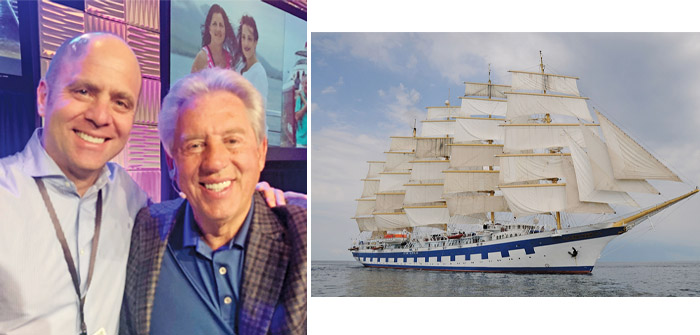((L) David Rosell & John Maxwell. (R) Royal Clipper | Photos courtesy of Rosell Wealth Management)
John C. Maxwell, one of our country’s top leadership experts, eloquently said “the pessimist complains about the wind. The optimist expects it to change. The leader adjusts the sails.” Maxwell’s message about controlling our destiny, along with his books and talks, positively impacted my life. In this powerful quote he related his philosophy to a good sailor, which got me thinking about how the important lessons of sailing can teach us important lessons of investing.
Last month I had an opportunity to sail on the Royal Clipper. This steel hulled, five-masted tall ship is listed in Guinness World Records as the largest full-rigged sailing ship in the world. Her 42 sails require a crew of 20 to get this 430-foot clipper ship, along with her 148 passengers and crew of 106, to 17 knots on sail power alone! When I first set my eyes on her, it was love at first sight as I thought she was an apparition from the grand old age of sail. Although she possesses all the grandeur and tradition of previous centuries, once aboard I quickly realized the Royal Clipper is as new as tomorrow, possessing all the comforts of today.
Each evening, as we set sail for the open seas, the emotionally powered Conquest of Paradise — the song composed by the Greek composer Vangelis — would bellow from the speakers. It was an experience that I can best describe by saying it was spiritual. The last evening, with a gin and tonic at my side, I started thinking about this next article that I needed to write for the Cascade Business News. It was then that I started thinking about the parallels between investment lessons and experienced sailors. Below I share nine valuable lessons in sailing and how they are reflected in investing.
- Sailors always set a course and keep an eye on the finish line. John Maxwell stated: “Leaders need to remember that the point of leading is not to cross the finish line first. It’s to take people across the finish line with you. For that reason, leaders must deliberately slow their pace, stay connected to their people, enlist others to help fulfill the vision and keep people going.” As investors approach retirement, I believe it’s imperative to develop a long-term investment plan that prioritizes the following key investment objectives: Capital Preservation, Income Generation and Growth of Principal.
- A sailor takes advantage of strong winds. Investors should be aware of developments and trends in the financial markets. As inflation hits a 40-year high, I’m confident interest rates will finally be increasing. This often has a detrimental impact on bonds. Is your retirement portfolio prepared for the inevitable? Bonds historically have been associated to safety. I like to say: One needs stocks to live well and bonds to sleep well, however this may not be the case for the next investment chapter of time. You may want to learn ways to mitigate interest rate risk.
- Sailors stay focused and so should investors. Don’t get distracted by the latest investment fad or fears that make headlines. If your investment objective is income generation, then the latest tech IPO is probably not for you. Keep in mind that a six percent annual return will double your money every 12 years. As one gets closer to retirement it’s important to shift our mindset to the return of your money taking precedence over the return on your money and yet it’s imperative to outpace the damaging impact of inflation.
- If you’re not familiar with your boat (or investment portfolio), you shouldn’t get into it. Understand your investment strategy, long-term objectives and risk metrics. Warren Buffet preaches the importance of investing in what you know… and nothing more, stating: “Never invest in a business you cannot understand.” One of the easiest ways to make an avoidable mistake is getting involved in investments that are overly complex. In my view, the majority of companies operate businesses that are too difficult for most people to comfortably understand. If I cannot get a reasonable understanding of how a company makes money and the main drivers that impact its industry within ten minutes, I move on to the next idea. Peter Lynch once said, “Never invest in an idea you can’t illustrate with a crayon.”
- As weather changes sailors make adjustments. Investors also need to be flexible and make changes to their portfolio over time. You also should periodically rebalance your portfolio. As the market goes up and down, your portfolio’s allocation will change — a run-up in small cap value stocks, for example, will increase the percentage you own in that sector, putting your portfolio out of balance. When you rebalance, you sell some of your winning sectors and buy more of the sectors that have not yet performed as well — thus conforming to the classic investment advice of “buy low, sell high.” Rebalancing can help prevent your portfolio from taking on more risk than you had originally intended—and help you avoid possible losses when a formerly hot sector starts declining.
- Sailors understand the wind (or the markets) can’t be controlled, but that the wind can be used to your advantage. Most people try to adjust their portfolio allocation based on what the market did. This is like letting the wind take you where the wind goes. Instead, design the sails, with the entire boat, to take advantage of any current and wind to be able to steer your sailboat towards your destination or in this case your retirement goals. Arriving at your destination is more likely when you understand the difference between what you can and can’t control.
- Successful sailors often recognize when to head in a different direction from the rest of the fleet. Investing success is often achieved by choosing a direction that is different from the path the herd is following.
- Sailors always have a toolbox onboard. It is important to become educated on all the different investment tools that are appropriate for you, their pros and cons as well as their fees so that you can choose the combination of tools that can best help you reach your destination — financial independence.
- Look for an experienced crew with complimentary skills. Veteran investment managers can help produce consistent performance. Look for managers who’ve navigated through a variety of conditions over numerous market cycles. Choose an investment partner that collaborates with you in setting an appropriate course based on your individual investment objectives. Active managers continually monitor the investment markets and make adjustments when the winds shift.
Smooth seas do not make for talented sailors. There will always be unforeseen rough seas with the markets, interest rates, inflation, oil prices, real estate, etc. Taking lessons from talented sailors and applying them to your long-term investment plan can help you achieve your financial goals and live the life you have imagined. In the meantime, I suggest adding a sail on the Royal Clipper to your bucket list!
David Rosell is president of Rosell Wealth Management in Bend. RosellWealthManagement.com. He is the host of Recession-Proof Your Retirement Podcast and author of Failure is Not an Option — Creating Certainty in the Uncertainty of Retirement and Keep Climbing — A Millennial’s Guide to Financial Planning. Find David’s books at local bookstores, Amazon, Audible as well as the Redmond Airport.
Investment advisory services offered through Valmark Advisers, Inc. an SEC Registered Investment Advisor Securities offered through Valmark Securities, Inc. Member FINRA, SIPC 130 Springside Drive, Ste. 300 Akron, Ohio 44333-2431. 800-765-5201. Rosell Wealth Management is a separate entity from Valmark Securities, Inc. and Valmark Advisers, Inc.




